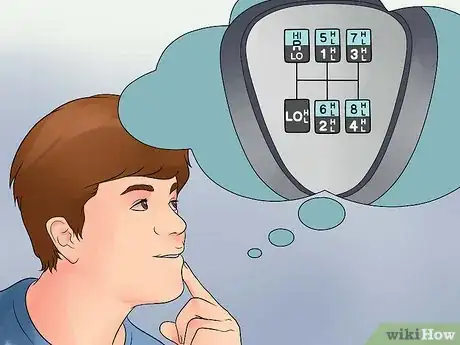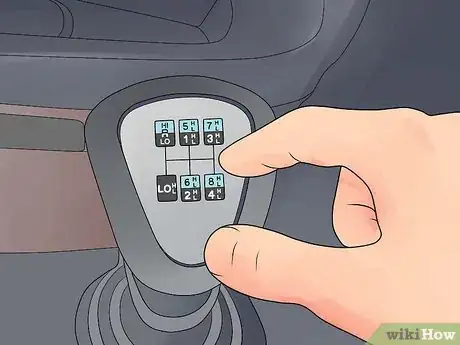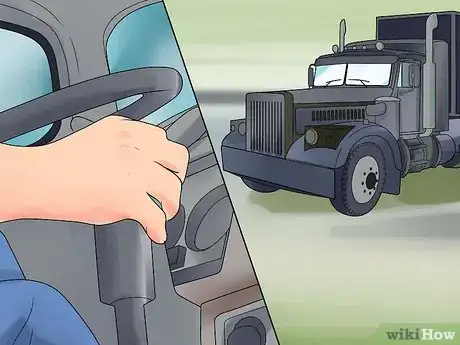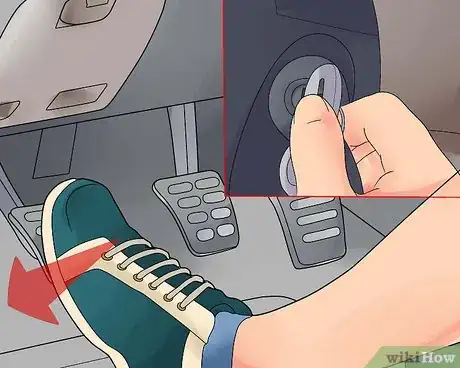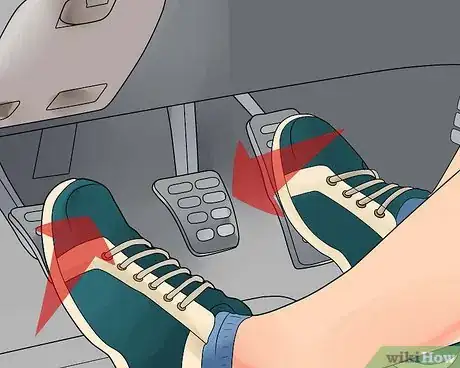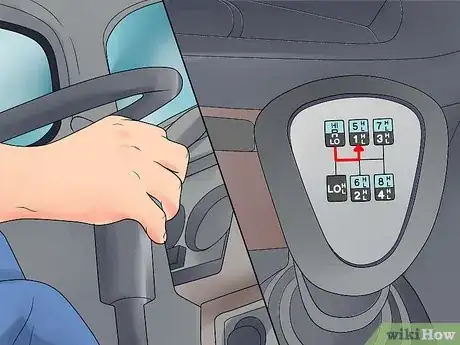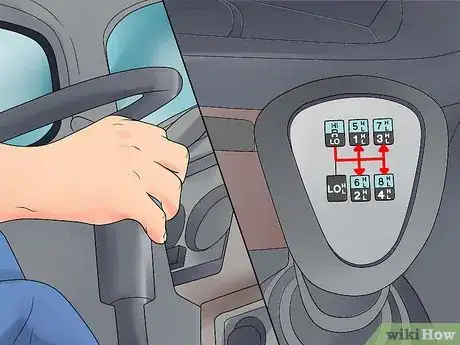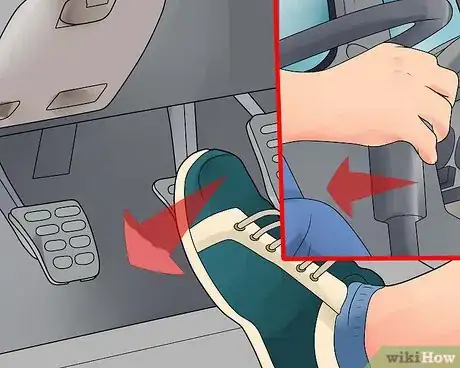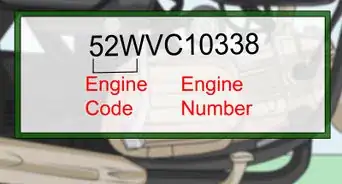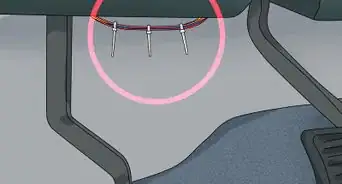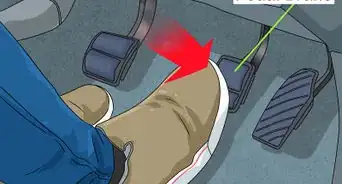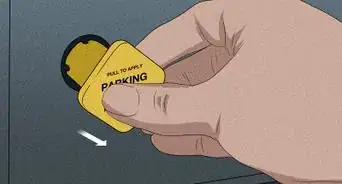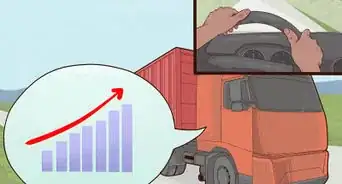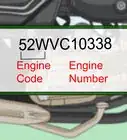wikiHow is a “wiki,” similar to Wikipedia, which means that many of our articles are co-written by multiple authors. To create this article, 24 people, some anonymous, worked to edit and improve it over time.
There are 7 references cited in this article, which can be found at the bottom of the page.
wikiHow marks an article as reader-approved once it receives enough positive feedback. This article received 16 testimonials and 90% of readers who voted found it helpful, earning it our reader-approved status.
This article has been viewed 606,950 times.
Learn more...
Learning to drive a semi truck properly requires lots of training and experience, but if you're curious about the basics of shifting one, you can get a primer on the steps that you'll need to practice if you want to drive the big rigs. Learn how the gear shifter workers, how to shift between gears, and some tips for knowing when to shift.
Steps
Understanding the Gear Shifter
-
1Understand how the gear shift differs from a normal vehicle's shifter. If you're familiar with a manual transmission, the basic principles of the Eaton-Fuller Transmission shifter–the style used in many commercial trucks today–is similar, but more complex. Basically, it's oriented like a five-speed, but with a total of four different ratios at each position, which you toggle by a combination of switches and positions. This results in a total combination of 18 different speeds.[1]
- The shift knob has two switches controlling air-actuated gears. One is the range switch, which needs to be set on "Low" for gears Lo-4, and the other is the high/low splitter, which is used to toggle between the low and high setting at each gear. Your index finger operates the range switch, which allows you to flip between high and low at each gear position with your thumb.
-
2Learn the gear shift pattern. Most gear shifts have a diagram displaying the shifting pattern, which will help to clue you into the organization of the gears.[2] The low gears are usually differentiated from the high gears by color, and reverse is indicated by an "R."
- Gears 1-4 should all be straightforward, but then to shift into fifth gear, you shift back to the first position, and the pattern repeats. First gear is in the same position as fifth, second in the same as sixth, and so on.
- Remember, at each position, you also have a total of four different speeds, though only two will be accessible, depending on where you shift from. In first gear, you've got 1L and 1H, as well as 5L and 5H.
Advertisement -
3Practice the gear pattern of the semi while the truck is stopped. This allows you to become familiar with the gear pattern so you can shift up and down without looking. This will help you keep your eyes safely on the road while driving.
- Grip the gear shift so that your index finger is available to work the range switch, and the middle and thumb can work the high/low splitter.
- If you don't have experience operating the clutch and driving a manual transmission vehicle, shifting a semi truck is going to have a much larger learning curve. Operating the gear shifter by itself is challenging enough, so you need to be very comfortable operating the clutch on a regular vehicle before you attempt to drive a semi. Practice on a regular car.
Getting into Gear
-
1Start the truck. Hold the clutch pedal to the floor, as you would to start a normal manual transmission vehicle. This stops the transmission gears from turning, which allows the shifter to slide into gear. Select “LoL” by moving the shifter into the Lo-gear position, usually left and back.[3]
- Check to make sure the range switch is in the low position (down), and the splitter is also on "L" and you'll be ready to start the vehicle.
-
2Push down the accelerator and slowly release the clutch. As you might guess when the vehicle's got 18 different speeds, getting the truck into Lo gear on Low setting will get you going about one mile per hour, if that. Once you've slid into it, release the clutch and you'll probably be ready to shift into Lo-H.
- To shift into Lo-H, you'll change the splitter to High gear to shift into high. You need to depress the clutch slightly, but not all the way to floor, then let it out to shift into Lo-H.
-
3Double-clutch to shift into first gear, low setting. Depress the clutch again slightly (not to the floor) when the RPMs reach first-gear range, and switch the splitter back to "L," then pull the gear shift into the neutral position and release the clutch. Depress the clutch again, all the way, and push the gear shift into first, as you release the clutch.
- This is called double-clutching, and it's necessary because you can't split between low and high on the splitter while you're in neutral, meaning that you have to toggle from "H" back to "L," then shift into neutral, then operate the clutch again to get it into first. It's a lot of work.[4]
-
4Continue this pattern through the first half of the gears. After you shift into 1-L you can flip the high/low switch up into the high position, continuing to accelerate and continuing this basic pattern through the upper gears.
- Repeat the previous steps through 1-H, 2-L, 2-H, 3-L, 3-H, 4-L, and 4-H. To make the half steps, continue pushing the splitter button, releasing the accelerator, pushing in, and releasing the clutch.
-
5Switch over to fifth gear when you're ready. With the splitter switch in “L," flip up the range selector to 5-H, which will allow you to avoid grinding gears when you switch back into the first position. This is absolutely essential. Switch the range, then double-clutch-shift back to where 1 was before, and it will be fifth gear.[5]
-
6Continue shifting through the higher gears. The basic principles now repeats itself. Continue shifting and toggling between "L" and "H," shifting up through 5-H, 6-L, 6-H, 7-L, 7-H, 8-L, and, finally, 8-H.
Knowing When to Shift
-
1Use the color indicators on the tachometer. Most RPM gauges should be color-coded, with 1500 rpms at about the top (12 o'clock) of the gauge, which is typically colored green. This is the ideal place to shift between gears.
- 1700-2100 is typically beyond the point where you should be shifting, with the exception of going downhill. This region is typically colored Yellow, with anything above colored red.
- If you're less than 1200 rpm and try to shift, the engine is likely to splutter and possibly stall.[6]
-
2Get used to the general shifting conditions. After a while, you'll be able to familiarize yourself with the general positions that you need to shift, but in instruction school, you learn a few basic rules of thumb.
- Be in top gear at 50 mph (80.5 km/h) or greater. Generally speaking, if you're traveling at highway speeds or greater, you should be at top gear always.
- Be in fifth or sixth gear for sharp turns in city conditions. To avoid stalling, it's good to be switched over into the upper gears.
- Other general speed guidelines will vary from transmission to transmission, for different trucks. You'll need to ask your instructor or other experienced drivers for tips.
-
3Downshift whenever you're slowing down. To downshift, you need to slow down to the rolling speed by hitting the brake, then select the gear for that range. Typically, you need to rev up to 1400-1600rpm, then slip the transmission into the proper gear for that speed range.[7]
Community Q&A
-
QuestionWhere is the splitter button on my shifter?
 Community AnswerOn every Eaton transmission there is a different setup. For the one that is mentioned, the "splitter" is on the left side of the knob and the range selector is the toggle switch directly on the front portion of the shaft. On a 10 speed, you do not have a "splitter" but only a "range selector", however on a "Super 10" all it has is a "splitter".
Community AnswerOn every Eaton transmission there is a different setup. For the one that is mentioned, the "splitter" is on the left side of the knob and the range selector is the toggle switch directly on the front portion of the shaft. On a 10 speed, you do not have a "splitter" but only a "range selector", however on a "Super 10" all it has is a "splitter". -
QuestionCan I put it in neutral and start breaking instead of changing down?
 Community AnswerThat's too dangerous because you are free wheeling in neutral and may gain so much road speed that you'll be unable to get back in gear in time.
Community AnswerThat's too dangerous because you are free wheeling in neutral and may gain so much road speed that you'll be unable to get back in gear in time. -
QuestionHow do I shift a truck into neutral?
 Community AnswerIf in gear, pull out and you'll be in neutral. Neutral is what you should always put your truck in when parking and when starting it up.
Community AnswerIf in gear, pull out and you'll be in neutral. Neutral is what you should always put your truck in when parking and when starting it up.
Warnings
- Do not use the splitter button in neutral.⧼thumbs_response⧽
Professional Semi-Truck drivers don't use the clutch except for selecting the first gear. Listen to the engine sound to judge shift points, and lightly feel for the gear, don't grind the tranny. Also, depending on load weight, you don't have to split every gear
References
- ↑ http://www.caranddriver.com/features/how-to-shift-a-semi-feature
- ↑ https://www.smart-trucking.com/18-speed-transmission/
- ↑ https://www.caranddriver.com/features/a16580626/how-to-shift-a-semi-feature/
- ↑ https://www.smart-trucking.com/double-clutching/
- ↑ http://fastertruck.com/pages/Trucker-Training-Videos-Shifting-Big-Rigs.html
- ↑ http://driver-safety.wonderhowto.com/how-to/shift-18-speed-semi-truck-193891/
- ↑ https://careertrend.com/how-5953435-drive-10-speed-transmission.html
About This Article
To shift gears in a semi truck, start by pushing down on the clutch pedal and moving the shifter into the Lo-gear position. Next, push down on the accelerator, release the clutch, then depress the clutch slightly as you pull the gear shift into neutral. Then, depress the clutch all the way to the floor, and push the gear shift into first as you release the clutch. Continue this pattern for the first half of the gears, then flip the range selector to 5-H, or fifth gear, to avoid grinding gears when you switch back into the first position. To learn more, like how to downshift when you need to slow down, keep reading!
